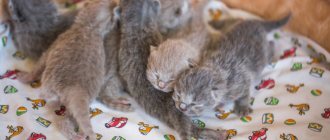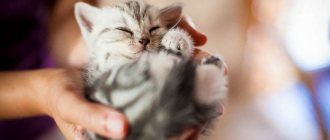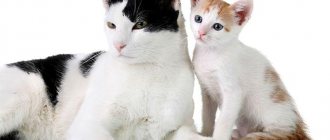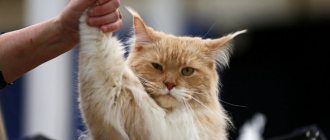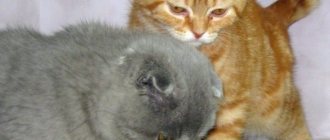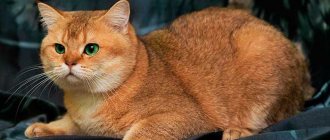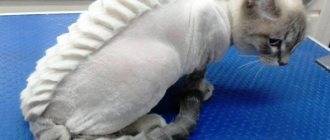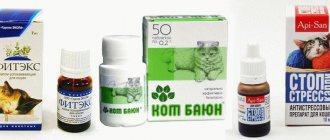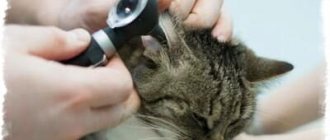Beautiful and noble British cats, dressed in plush fur coats, can leave few people indifferent. Their character is far from simple. But this does not diminish their popularity at all. . How many years do British cats live, what is the lifespan of cats at home , these questions interest many fans of the breed.
The British are distinguished by good health and good immunity, which is explained by their origin. With good care and subject to a number of rules, they can live up to 15-16 years.
What determines the life expectancy of a British cat?
| Proper nutrition | Must be correct, regular and balanced |
| Disease Prevention | Vaccinations |
| Treatment for parasites | Regular intake of medications against worms and ticks |
| Visit to the veterinarian | Regular inspection |
| Weight control | The British have a tendency to be overweight, strict control over this is needed |
| Control over the reproductive function | If breeding is not planned, castration or sterilization will be required |
| Activity | Physical activity required |
| Conditions of detention | Good care and good hygiene |
| Provoking situations | Avoid stressful situations |
How to extend the life of a Briton
There are certain rules of care, if you follow them, the animal can live a long life. Otherwise, even the healthiest cat will not live longer than 5 years. The lifespan of a person directly depends on the conditions in which he lives.
If a cat lives in a house, then it can live to an old age. Domestic fluffies delight owners from 12 to 17 years old. However, the exact lifespan depends on many circumstances. Outdoor cats live much shorter lives. No more than 5 years.
British woman giving birth
If a British cat begins to secrete a yellow, pus-like fluid from under its tail, these are the first signs of the onset of labor. In addition, any cat before giving birth begins to scream unnaturally and refuse to eat.
The first time British women give birth is quite difficult, and they may call the owner to deliver the baby. Therefore, it is recommended to be at home on a pre-calculated day and stock up on:
- veterinarian's phone number;
- clean scissors;
- surgical gloves;
- Vaseline;
- nylon thread;
- any antiseptic.
A serious complication of the approaching birth can be premature release of water and a kitten stuck in the birth canal. In this case, you will need the help of a veterinarian; under no circumstances try to get the kitten yourself!
On average, the first birth lasts about 10 hours. In some cases, it can last 24 hours, but no more.
Fold-eared Briton - reality or myth>>
In one litter, a British cat gives birth to up to 6 kittens. After giving birth, the “new mother” sometimes behaves unpredictably - she does not agree to feed the kittens or even turns away from them. In this case, the owner just needs to help his cat by placing the babies one by one on her nipples. After some time, she will feel a familiar smell, begin to lick them and, finally, “recognize” them.
How to name a British cat >> How to name a red, black, gray kitten >>
The correct lifestyle of a British cat
Genetically, Britons are prone to a number of diseases. First of all, to excess weight. You need to provide your pet with a calm environment. Stressful situations are strictly contraindicated for these cats. It is necessary to give phlegmatic pets the opportunity to move. Because they need to expend accumulated energy.
You need to play with your pet and stimulate its mobility. To do this, you need to purchase toys and deal with the handsome plush.
Nutrition
The lifespan of a Briton directly depends on the quality of food. To create the right menu, you need to take into account several nuances:
- For what purpose was the animal purchased (for the “soul” or to produce offspring).
- Age category;
- Feature of this breed.
Proper nutrition for a British cat
British cats are quite large by nature. Adults, especially males, can reach a weight of more than 6 kg. Females are slightly smaller. In size, they are slightly inferior to Maine Coons and other large cats.
The disadvantage of this breed is its tendency to gain weight. This problem is especially encountered by cats after castration. That is why you should choose your diet carefully.
You need to decide on the type of food. Mixing several types of food, for example, dry and natural, is strictly not allowed. This can lead to stomach diseases. Don't get too carried away with fish. Representatives of the breed are predisposed to diseases of the excretory system.
The diet should be balanced. Fatty foods are excluded. Meat, a small amount of fish, boiled vegetables and cereals, as well as dairy products are welcome.
Conditions of detention
Plush fur should be brushed regularly with a special comb. It is especially important to carry out this procedure during periods of active molting.
You need to keep your ears and eyes clean. It is recommended to clean your ears every two weeks. Rub your eyes regularly.
If walks are planned, then the owner's accompaniment is mandatory.
Conditions for keeping a British cat
Bathing and hygiene
Don't bathe your cat too often. This may damage delicate skin. In case of severe contamination, water procedures are carried out using special shampoos. The water should be cool. It is very important to secure your pet so that water does not get into the ears. In order not to provoke otitis media.
Physical activity
The British have a strong immune system and a thick, plush coat. Therefore, they can and should be walked outside (subject to vaccinations) at normal temperatures. In urban conditions this is problematic, there are too many cars and stray dogs.
Disease Prevention
You should carefully monitor the ears, fur, mouth, and eyes. To avoid serious diseases, cats are given anthelmintic drugs twice a year. The first vaccination is given at three months of age. Then annual vaccinations are required against common infectious diseases of cats (chlamydia, rabies and others).
You can avoid serious illnesses by regularly taking your pet to the veterinarian.
Castration (sterilization)
If further breeding of British cats is not planned, then such an operation is desirable. The inability of a pet to lead a full life does not have the best effect on its health.
As for age, the British reach sexual maturity at 7-9 months. After the first heat, the cat can be spayed.
Castration of a British cat
Psychological well-being
The character of the British is very specific and this must be taken into account when choosing this breed. For a plush cat, people are more likely to be service staff. He will not pester them with his caresses or attempts to climb onto his lap. Rather, on the contrary, the pet will resist the intrusiveness of the owners in every possible way. The appearance of a noisy company will be extremely stressful for him.
A stressful situation for him will also be the fact that the owner, for example, was late at work and did not return home on time. Only selected people will allow the cat to scratch itself behind the ear. The British are tolerant of children, but they are completely unsuitable as a living toy.
Breed Features
The homeland of the British is Italy and Egypt.
The unusual appearance of the animals made them real kings of exhibitions. Representatives of the breed have a large body with well-developed muscles and “plush” fur that is unusually pleasant to the touch. The British have a wide, muscular back. The tail is thick, somewhat tapering at the tip. The ears are erect, slightly rounded. The coat is short, with a thick undercoat. However, there is also a long-haired variety of the British. The color can be anything: from white to black, like ebony. The most common colors are smoky blue and striped. The cats of this breed of “Siamese” color, or colorpoint, are very beautiful.
Cats are friendly with family members and get along well with other pets. They are wary of strangers. However, once you understand that the stranger does not pose any threat, the good-natured Briton begins to caress and purr.
The British get along well with children. Fans of the breed even compare them to nanny dogs, such as German shepherds or collies. Throughout their lives, cats remain playful, but the character of these cats is unobtrusive. They do not try to win the attention of the owner, however, they never refuse outdoor games.
How to extend the life of British cats
So, in order to enjoy your plush, self-sufficient and self-satisfied handsome man for as long as possible, you should take proper care of him. Get vaccinated, visit a veterinary clinic for timely health monitoring, and give him the right diet.
Regular and timely prevention of diseases in cats
It includes preventive vaccinations, treatment against parasites and ticks.
Proper feeding
Natural food or ready-made dry food is suitable for feeding your cat. The diet must be properly composed and provide the pet’s body with everything it needs. You should not combine two types of food. It's better to stick to one thing. Either dry food or natural food.
Hygiene and care
Regular pet care is required. Ears and eyes should be kept clean. If necessary, the pet is bathed with special shampoos. Comb out the fur.
Education and exercise for a cat
You should pay attention to raising your pet from the very first day in the house. An important point is to train the cat to relieve itself in the litter box. It is worth remembering that these animals are very clean. Therefore, after each visit, the toilet is thoroughly cleaned and washed.
If your pet doesn’t like the quality of cleaning, he will find a more suitable place himself!
Important educational moments include learning to use your own name. You should not allow your pet to climb on the table and steal food.
To maintain a slim figure, the cat needs active games.
Limiting stress factors
If you plan to have a noisy company in the house, then it is advisable to provide the cat with a calm and secluded place. At the same time, you should not leave her alone for a long time. You should visit your pet regularly and provide food and water. For all his independence, the Briton is very attached to his master.
Sterilization and castration
They are necessary if you do not plan to breed cats. The optimal age is after 9 months, when the pet becomes sexually mature.
How long do Scottish Fold cats live?
Cats of the Scottish breed or Scottish Fold stand out among the cat tribe not only by the unusual shape of their ears. The undoubted advantage of these lop-eared cats is their calm and easy-going nature; they are very affectionate, but not annoying. There is another important fact that contributes to the growth of their popularity. Among the cat tribe, Scottish Folds are considered long-lived, existing next to humans and giving the joy of communication for more than ten years.
The first fold cat appeared in 1961 in Scotland. She became the ancestor of all folds, obtained by crossing her descendants with British Shorthair cats.
Scottish fold cats and male cats are different:
- medium sized rounded body and head with a strong build;
- thick massive limbs with large pads;
- small ears rounded down;
- large round and expressive eyes of stunning shades;
- thick, short and soft, like velor, coat of various colors.
Scottish Fold cats have good health at the genetic level. This is the basis of their longevity.
At home, Scottish Fold cats live 15-20 years
In good conditions, surrounded by care and attention, they are able to live longer than the average. To create such conditions, animal owners need to know the “weak” points of the breed and be able to correct them. Like any other cat breed, Scottish Folds have their own “weaknesses”:
Like any other cat breed, Scottish Folds have their own “weaknesses”:
1. Despite the outwardly strong skeleton, cats of this breed have a rather vulnerable skeletal system. With the exception of congenital anomalies, and there are such, problems with the growth of bones and cartilage do not appear immediately, but as the animal grows older. In most cases, they can be solved, but they negatively affect the life expectancy of a pet. 2. A balanced diet will help prevent the occurrence of another problem of this breed - the tendency to be overweight. It is provoked by a lack of protein in food, an abundance of carbohydrates and the animal’s excellent appetite.
Therefore, it is so important to monitor your pet’s diet, adjust it if necessary, and monitor the animal’s height-to-weight ratio. 3
Scottish Folds love to be brushed
This procedure not only improves the mood of your furry pet, but also prolongs its life. Being the owner of thick fur, it is difficult for Scottish Folds to clean or lick it on their own. The wool becomes matted, forming tangles. In advanced cases, tangles impede the animal's movement, causing physical inactivity, and, as a result, lead to an increase in body weight. Excess fur, entering the stomach, forms into dense lumps. They are difficult to remove from the digestive tract and provoke disturbances in its functioning. Timely combing, especially in combination with bathing, will reduce the risk of digestive diseases and make the coat of lop-eared pets well-groomed and beautiful. 4. The special structure of the ears obliges owners not to forget about their hygiene. It seems that the ear holes are securely covered. However, dust, dirt, and sometimes insects, such as mites, freely penetrate the ear canals, clogging and causing discomfort, followed by disease. Fold-eared cats need careful ear hygiene. It should be done no less often than for cats with regular ears.
Fold kittens are born very small, they weigh only 100 g. Raising a kitten will be much easier if you buy a healthy baby. A careful examination of the animal and observation of its behavior will help you make the right choice.
It is recommended to purchase Scottish Fold kittens at the age of 2-3 months. By this time, their body has fully formed and is strong enough to endure the move and successfully adapt to new conditions.
To reduce the risk of problems with the skeletal system, when choosing a kitten, you need to examine its paws and tail. The joints of the limbs should be mobile, easily bend and unbend without causing negative emotions on the part of the animal
It is also necessary to pay attention to the quality of the coat, the cleanliness of the tear and ear canals
Possible diseases of the British cat
This breed was obtained artificially. Representatives have a tendency to genetic and acquired. Since the British are closely related to Persian cats, they are prone to eye diseases. If fed improperly, pets may develop intestinal and stomach diseases. The article has already mentioned the tendency to be overweight. Careful weight monitoring is required. There is also a genetic predisposition to joint diseases. Another weak point is the heart. That is why the animal needs to be protected from stressful situations. Neutered cats often suffer from urolithiasis.
Possible diseases of the British cat
Castration and sterilization of the British
They are carried out when animals reach sexual maturity. What happens at seven months of age?
When to castrate a British cat
The best option is to castrate an untied cat at a young age. The most suitable age would be 9 months or 1.5 years. If the operation is performed earlier, the cat’s development will slow down.
Sterilization of British cats
If the question is when is the best time to perform such an operation, then the age of the cat will be the same as that of the cat.
What affects health?
Scots, despite their charming appearance, are quite gentle and delicate in health for an experienced breeder. In the process of raising Scottish Fold cats, you can encounter the following common diseases.
These diseases, as a rule, do not directly affect the life of a young Scot, but they begin to actively manifest themselves in adulthood. Because of this, the pet begins to have problems with gait, running, and begins to limp. In turn, a lack of active games and entertainment leads to the development of obesity and a decrease in muscle mass. All these diseases can shorten the life of Scottish Folds by 3 or even 4 years.
- Grooming. Long-haired Scots breeds have surprisingly long hair, which without proper regular care can literally prevent the animal from moving. In addition, the formed wool tangles often become a haven for ticks and lice, as well as a source of development of inflammatory skin diseases. Poor grooming can also lead to physical inactivity (atrophy and weakening of the muscular system) if your pet does not move around much.
- Scottish Folds also love to lick themselves, which leads to swallowing a lot of long hair. Because of this, real hairballs and compactions often form in their stomach, which are then very difficult to remove from the body due to blockage of the passages. This can lead to complications in the gastrointestinal tract: diarrhea, constipation and loss of appetite.
In addition to the listed diseases, Scottish Folds are also characterized by other diseases typical of other cat breeds: skin diseases (fungal diseases, abscesses, abscesses, ulcers, rashes, allergic reactions), infectious diseases (salmonellosis, rabies, anemia, candidiasis), eye pathologies (pupil dilation, tear ducts, lens clouding), heart disease (hypertrophic cardiomyopathy), and some cancers.
Skin diseases
There is a fairly extensive list of skin diseases in cats. These include scabies and dermatomycosis. Fleas, mosquitoes and ticks, allergies are often the cause of eosinophilic granuloma. Hair lice and other parasites cause great suffering to furbabies.
Skin diseases of the British cat
The pet's belly hangs
The formation of a small skin fold in a British person may be normal. Scientifically, this fold is called the fat tail. It is worth observing the behavior of your pet. If he is active and has a good appetite, then there is no reason to worry. But if a hanging belly is associated with obesity, then it is worth reviewing the diet and putting the cat on a diet. If you have no appetite, you should be concerned and contact your veterinarian. The reasons for this phenomenon may be different.
British record holders
- A cat named Spike from England lived 30 years. Being at a respectable age (19 years), the cat was bitten by guard dogs, but survived safely and even became an example of longevity.
- Another long-liver, a gray-striped cat named Ma, lived for 34 years. She is remarkable for another quality: the cat was an excellent mousetrap.
Take care of your pet, you are responsible for it. Good nutrition, timely help from a veterinarian, moderate physical activity, minimizing stress - all this helps to prolong the active life of your pet.
